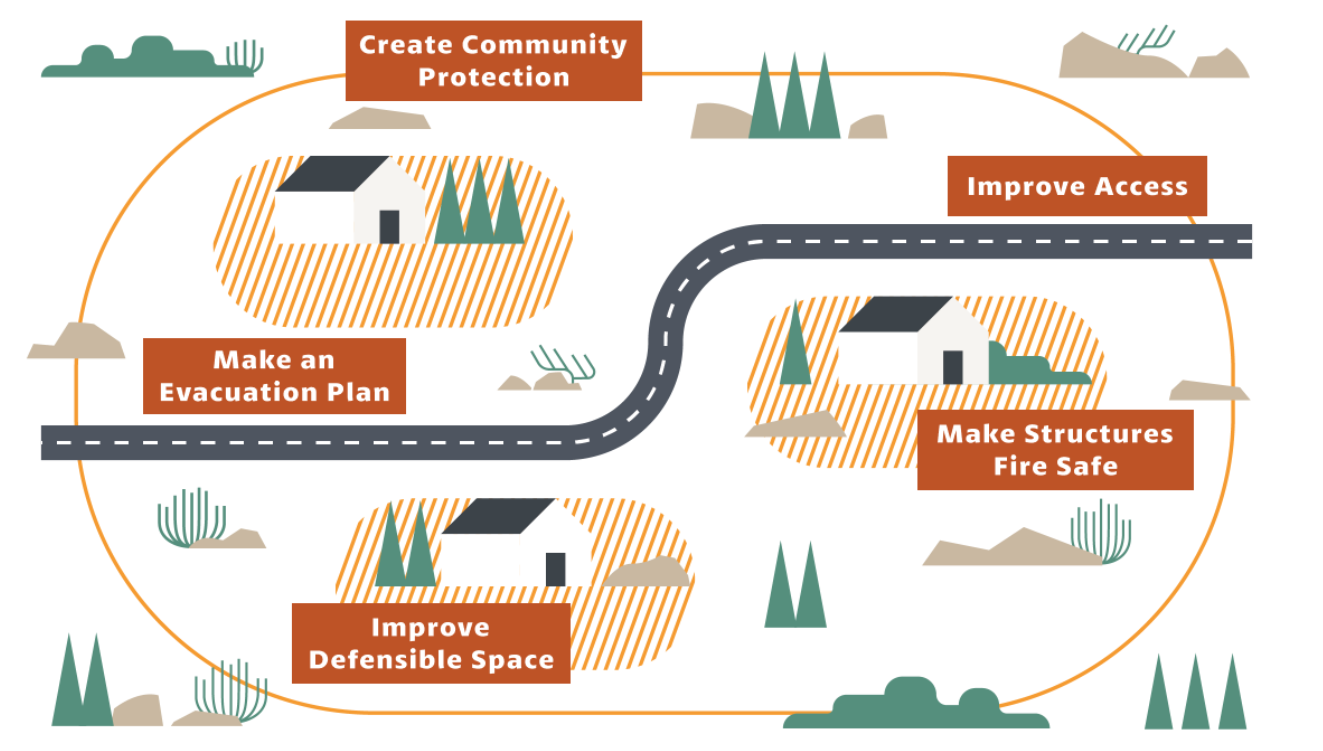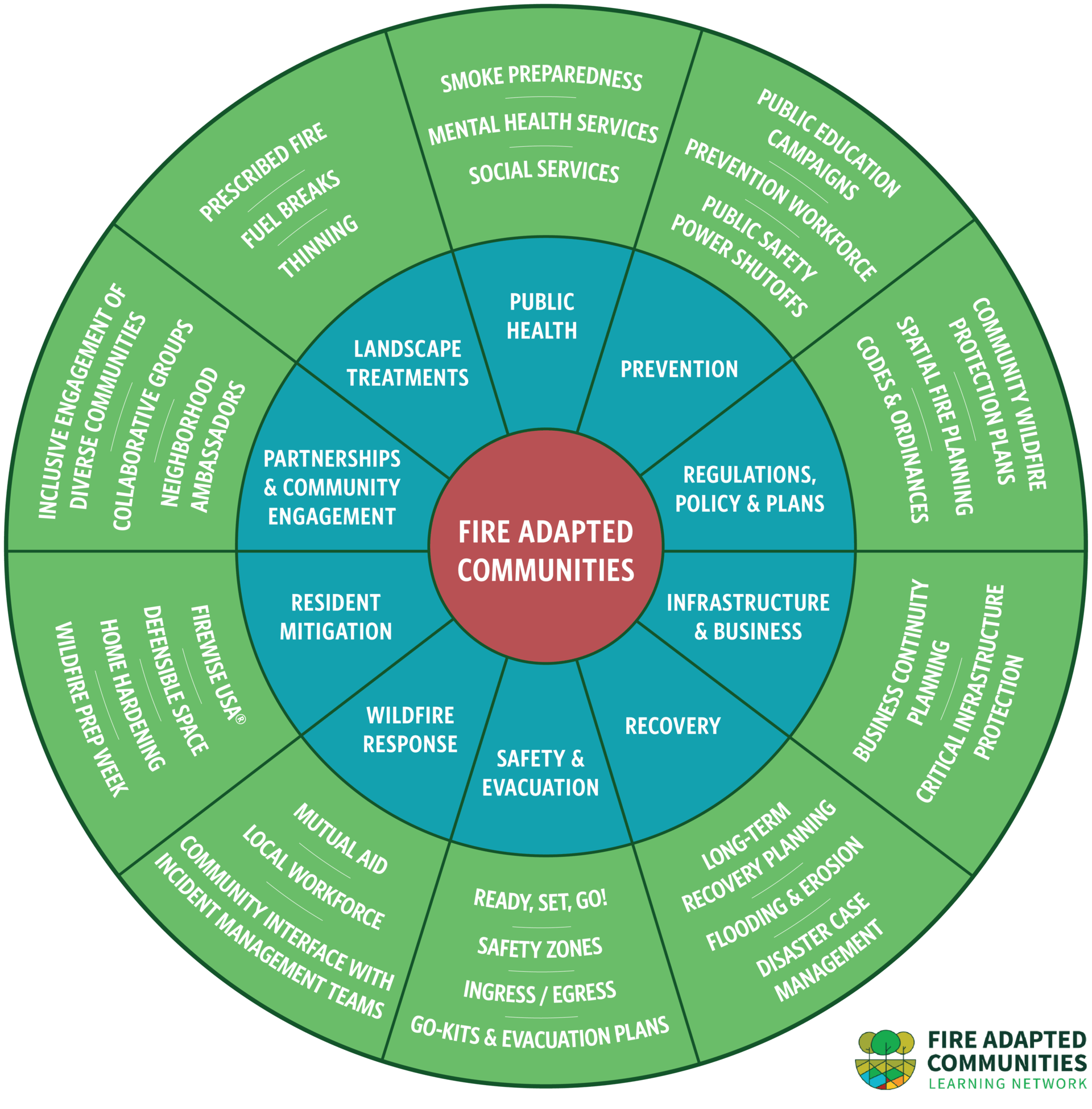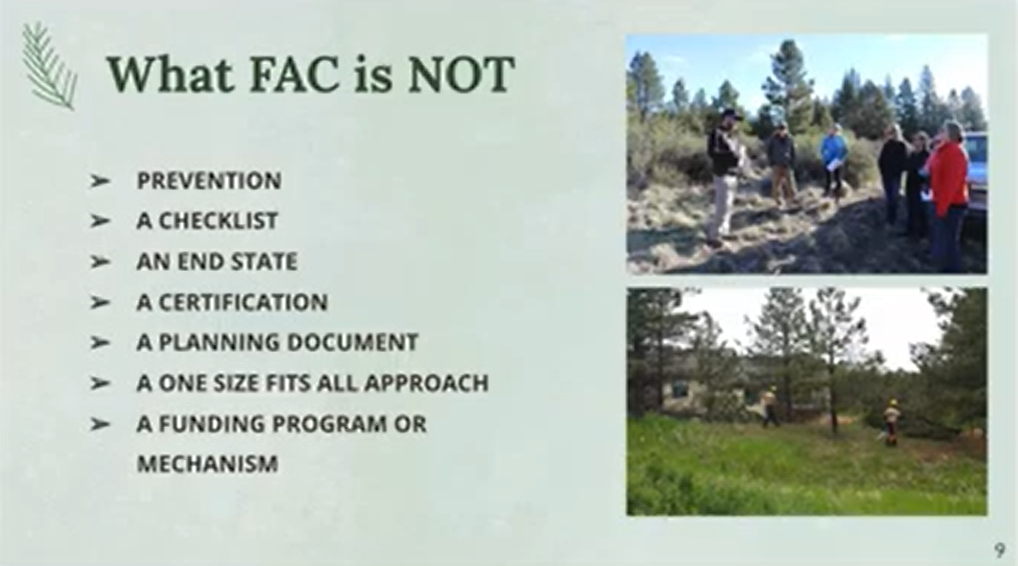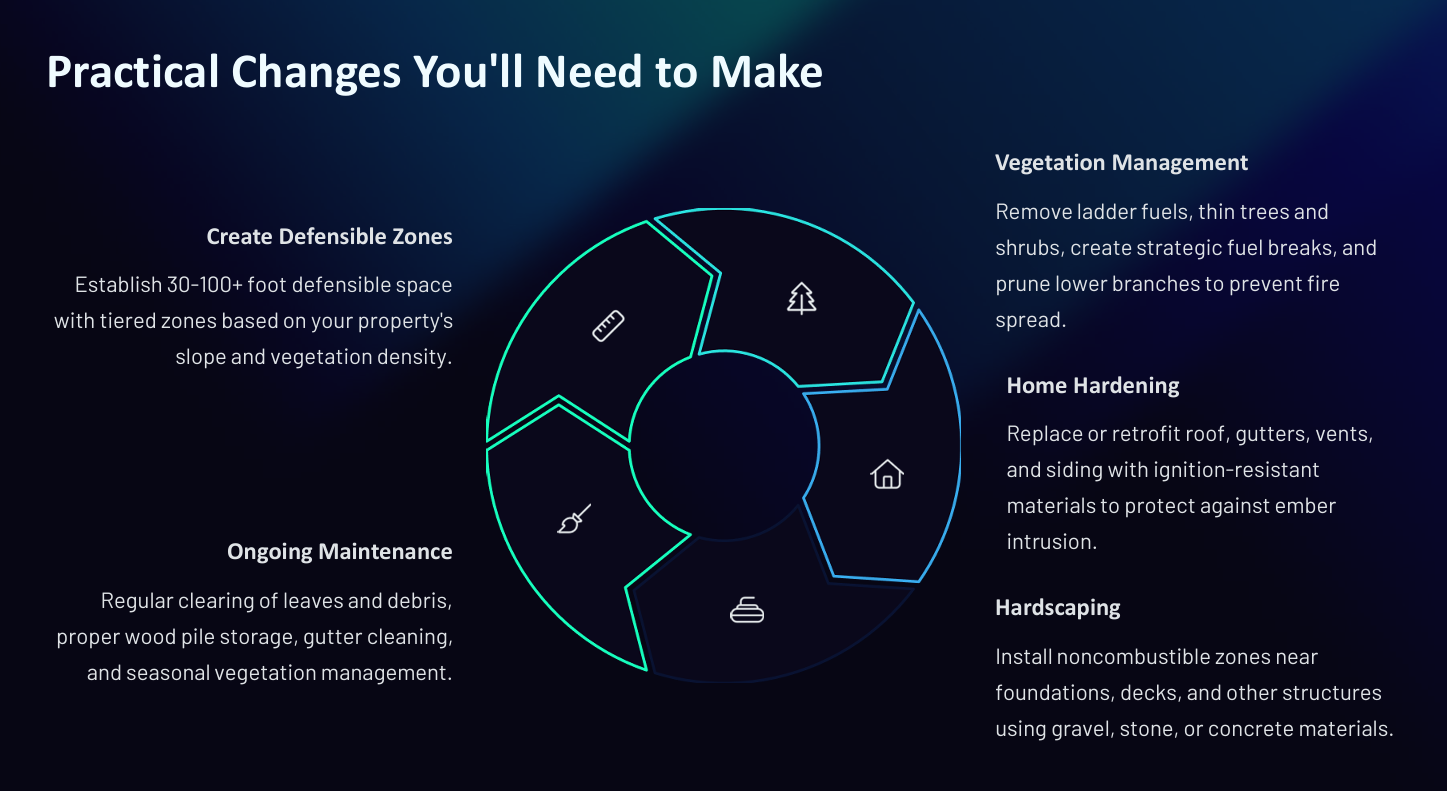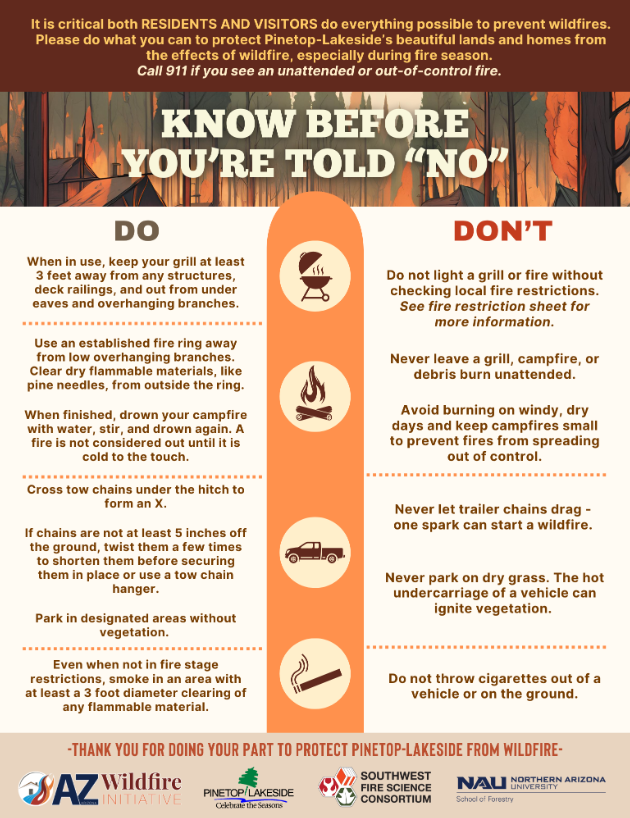Happy Fire Friday!
Fire adaptation is an alternative to the costly and ineffective model of relying solely on fire suppression for community safety; it empowers communities to prepare for wildland fires, mitigate their impacts, and recover more effectively when they inevitably occur. However, there are many tools, pathways, and angles to consider when creating fire ready communities. Firewise, a program of NFPA, has gained popularity over the last decade as a means to get neighbors and friends engaged with defensible space and home hardening, as well as a way to retain insurability. The program and title of Firewise Recognized Community is one tool, one approach, and it nestles will with other programs and frameworks. Since November 20th marks the renewal deadline for communities who are Firewise Recognized, today we will be exploring some of these tools and programs in-depth, how they differ and can work in tandem to educate and motivate, and how following the recommendations of each one may impact a community’s risk vs insurability.
This Wildfire Wednesday Features:
Upcoming virtual town hall from the NM Fire Planning Task Force
Resources for renters
Upcoming webinars
Be well,
Rachel
Simplifying Firewise and FAC
This information was originally shared in Wildfire Wednesday #96; view the newsletter and watch the recent FACNM webinar to learn more, including how to choose the right program for your community.
What is Firewise?
The Firewise USA recognition program is administered by the National Fire Protection Association (NFPA) and provides a collaborative framework to help neighbors in a geographic area get organized, find direction, and take action to increase the ignition resistance of their homes and community and to reduce wildfire risks at the local level. As Firewise Program Manager puts it, Firewise “fits into [the Fire Adapted Communities framework] as a tool. It’s not the only tool and it doesn’t do all things. It is the built environment piece [of the FAC preparedness wheel] - how do we help self-defined neighborhoods come together and get started on that [fire preparedness] pathway?”
Firewise focuses primarily on homeowner and resident fire mitigation before a wildfire. Their recommended mitigation actions include home hardening, fortification of the home ignition zone, organization of a Firewise community board, neighborhood risk reduction activities, and joining the program as a Firewise USA Site.
Through risk assessments, community organization, and individual and collective action, the goal of Firewise is to effectively lower community susceptibility to fire.
New applications can be completed online at portal.firewise.org. More information on creating a firewise home and community can be found below.
What is the Fire Adapted Communities (FAC) Framework?
Fire Adapted Communities is a holistic, adaptive, and comprehensive framework to help communities live better with wildfires. A fire adapted community is one which understands its risk and takes action during all phases of the wildfire cycle - before, during, and after - to be more resilient. FAC was born out of the 2009 National Cohesive Wildland Fire Management Strategy. FAC looks beyond residents and individual actions and broadens the scope of what it means to be fire ready.
The Firewise USA® recognition program is one of many tools a community can use to address its fire risk. Focused primarily on residents and residential action, the Firewise USA® program is an important piece of the wildfire adaptation puzzle. The International Association of Fire Chiefs’ Ready, Set, Go! Program, focusing on empowering fire departments to communicate with their constituents, is another common tool used as part of a community’s overall fire adaptation framework. Additional strategies such as evacuation planning, developing and updating community wildfire protection plans, adopting WUI codes and ordinances, conducting controlled burns and performing post-fire recovery planning all contribute to a fire adapted community.
View the FAC community resilience framework, smoke ready framework, and suite of actions by clicking on the graphics below.
FAC encompasses the Fire Adapted Learning Network, a peer learning and professional relationship-building initiative. FAC Net connects people to resources and to other practitioners so they can share approaches, tailor strategies for their place, and make a difference in wildfire outcomes on-the-ground. They combine support for on-the-ground project work with professional development, peer learning and coaching, and long-range strategic planning.
While FAC offers many resources and opportunities to learn from other people doing similar work, there is no formal fire adapted communities recognition program. It does not guarantee prevention of ignitions nor does following the recommendations tailored to your community lead to a certification.
Program impact: insurability vs risk reduction
What is impactful risk reduction?
Frameworks like Fire Adapted Communities incorporate decades of lessons learned and recommendations from fire experts to provide a comprehensive suite of actions that individuals and communities can take to reduce their overall fire risk, increase their home and property’s chances of survival, lessen the devastation and interruption to daily life that wildfires cause, and work together to recover better after a fire happens. These approaches are focused on hazard mitigation, education, preparation, and teaching communities how to live with fire.
The frameworks encourage community-level participation, because research has shown that collective action - everyone working individually, alongside their neighbors, to reduce their hazardous fuels, improve their structure’s fire resistance, advocate for improved routes of ingress and egress, etc. - creates a broad net of protection which is far more effective at reducing the impacts of a wildfire on the community than isolated individual action. Learn more about reducing risk. Following the recommended actions and approaches of these frameworks may help improve fire outcomes for the community; however, they do not guarantee insurability of homes and businesses.
What influences insurability?
“Viewed through a risk management lens, wildfire risk… throughout the western United States is becoming uninsurable. Risk is the product of hazard (the combination of the probability of wildfire and its characteristic intensity), exposure (where the item at risk is located and its value), and vulnerability (how damaging wildfire is to the item at risk)” (TNC, 2021). Insurance providers base their coverage decisions on many factors; when it comes to wildfire, underwriters will consider a property's fire protection class, location, proximity to fire services, exposure to nearby fire hazards, and the potential for loss as well as external factors such as wildfire and climate risk models. These factors culminate in an assessment and risk classification which then informs whether the insurer will offer coverage, and if so under what policy terms (e.g. coverage limits, deductibles, exclusions) and at what price. Home and business owners cannot influence many insurance assessment factors (e.g. the risk rating of a specific geographic location), nor know exactly what factors any given insurance provider will use (this is proprietary information). So what can you do reduce your property’s risk classification to retain or obtain coverage?
Start with the area around your home - is the structure itself built out of highly combustible materials? Are there gaps under the porch, along the roof, between door frames and windows where embers could land and smolder? Is the landscape immediately around your house thick with flammable vegetation? These things all contribute to your property’s risk rating and can be altered and improved.
The Insurance Institute for Business and Home Safety (IBHS) worked with insurance providers to create the Wildfire Prepared Home (WPH) program. The program is supported by property insurers and other affiliated companies, and some insurers are now offering policies for homes that meet the standard. WPH provides recommendations for creating defensible space and improving property construction by replacing highly combustible materials with fire-resistant options. This program from IBHS is coming to New Mexico in 2026; this means that residents who follow the recommendations of the program to reduce their individual risk can then have their property inspected and receive a Wildfire Prepared Home designation certificate. The certificate, which demonstrates that the home has met specific mitigation actions, can then be shown to insurance companies. The designation is valid for three years. Learn more about the potential for loss of insurance and the space IBHS is looking to fill by viewing this presentation from the 2025 New Mexico Wildland Urban Fire Summit.
Additional actions that a community can take to improve their chances of retaining fire insurance include:
Adopt and enforce local codes (such as defensible space ordinances) that require fire-adapted landscaping and/or ignition-resistant building materials and design.
Thin vegetation in common areas (not just individual properties) to reduce wildfire risk.
Create defensible space on neighboring public lands by working with public land agency urban lot management programs.
Improve infrastructure by creating clear emergency alert systems and evacuation routes and increasing access to fire hydrants.
Improve access by ensuring roads are wide enough for emergency response vehicles (fire engines) to pass and home addresses are clearly visible from the street.
Work with local fire departments and specialists to conduct professional home and community hazard assessments and develop mitigation strategies.
Additional resources
Upcoming virtual town hall from the NM Fire Planning Task Force
The next public meeting of the New Mexico Fire planning task force, hosted by the Energy, Minerals, and Natural Resources Department (EMNRD) Forestry Division, will be held at 9:00 AM on Monday, November 17th, 2025. Agenda items include updates from the wildfire risk priority mapping, defensible space standards, and communications sub-groups; an update on F.A.I.R. Insured Home Hardening Grants; a report from the Community Wildfire Protection Plan (CWPP) sub-group; State Forester’s update; a round robin open discussion; and time for public comment. View the full announcement and instructions for joining virtually (recommended due to limited space) or in-person.
…………………………..
Resources for renters
Many fire preparedness and educational resources are targeted toward home and business owners, leaving short- and long-term renters in an information void. Scroll down to see resources collected and tailored to renters:
Short-term rentals like Airbnb and VRBO are increasing across the Southwest. While beneficial for local economies, many visitors are unaware of the state’s wildfire risks or how to stay informed. To address this, the Southwest Fire Science Consortium and the Arizona Wildfire Initiative created a wildfire information packet for short-term rentals. This customizable resource educates guests on wildfire risks and provides tools to help them stay informed and make safer choices.
As of 2023, 30.7% of housing units in New Mexico were renter-occupied (U.S. Census Bureau). Additionally, certain demographic groups—such as young adults and individuals with less formal education—are more likely to rent, and rental rates among these groups have increased nationwide over the past decade. To help promote wildfire preparedness for all New Mexicans, Wildfire Wednesday #156 focused on resources for renters, including topics like evacuation planning, renters’ insurance, and post-fire recovery.
…………………………..
Upcoming webinars
Thursday, November 20, 2025, 2:00pm MT: Wood you believe it? Aspen interactions with fire and wildfire spread in the Southwest
From disease resilience to browse pressure, recreational value to fire resistance, aspen has gotten a lot of attention over the past few years. This webinar will offer insights on various aspects of the intersection between aspen forests and fire in the Southwestern U.S., including: the ability of aspen to slow fire growth and act as a firebreak, fire radiative power/burn severity in aspen forests of the Southern Rockies, and the relationship between stand composition and suppression strategies.

